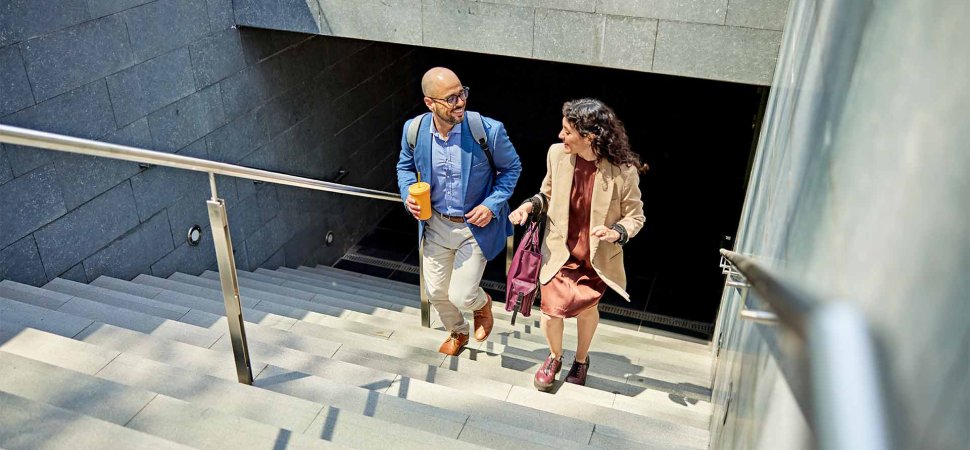
WANT TO LIVE A LONGER, HEALTHIER LIFE? THESE 2 MINUTES COULD SIGNIFICANTLY IMPROVE YOUR FITNESS AND CUT YOUR MORTALITY RISK BY 40 PERCENT
How to increase your lifespan and healthspan, no gyms, equipment, workout programs, or supplements required.
Here comes Captain Obvious with a news flash: People want to live longer. That's why there are so many innovations in the lifespan and healthspan space. Supplements. Ultrasound. Red light therapy. Magnet therapy. Cold tubs for ice baths.
A growing number of anti-aging startups involve entrepreneurial notables like Jeff Bezos, Google co-founders Larry Page and Sergey Brin, PayPal co-founder Peter Thiel, and OpenAI CEO Sam Altman.
Problem is, there's little scientific evidence to prove causal outcomes from cutting-edge longevity treatments.
So here's an old-school way to live a longer, healthier life: Run some stairs a few times a day.
A study of over 25,000 people published in Nature Medicine found that performing short, intense bursts of physical activity -- in this case, sprinting up two flights of stairs, walking back down, and repeating two more times -- three times a day made a dramatic difference in longevity: a 49 percent reduction in death from cardiovascular disease and a 40 percent reduction of death from all causes.
As the researchers write:
These results indicate that small amounts of vigorous intermittent lifestyle physical activity (VILPA) are associated with substantially lower mortality.
VILPA in nonexercisers appears to elicit similar effects to vigorous physical activity (VPA) in exercisers, suggesting that VILPA may be a suitable physical activity target, especially in people not able or willing to exercise.
To be honest, I'm not sure what the effective difference is between vigorous exercise activity and vigorous intermittent lifestyle physical activity. Maybe it's not going to the gym, but running up stairs seems like exercise to me. The researchers looked at brief and sporadic -- one- to two-minute -- bouts of vigorous-intensity physical activity done as part of daily living, like walking fast while commuting to work, or carrying heavy objects, or in this case, taking the stairs.
Maybe that's because lots of people don't like to exercise. As the researchers note, "Although vigorous intensity physical activity is time-efficient, vigorous structured exercise-based sessions (for example, gym-based, sports, high-intensity interval training) are not feasible or appealing to the majority of middle-aged adults, as indicated by the very low participation rates."
Maybe thinking "exercise" turns people off; maybe it helps to think of VILPA as the art of exercising without exercising.
And surely there's an addressable market. As the researchers write:
For most adults, VILPA may be more feasible than structured exercise because it requires minimal time commitment and involves no specific preparation, equipment or access to facilities.
Many common activities of daily living are likely to elicit relative vigorous intensity effort in physically inactive adults with poor fitness who do not habitually exercise, which is the majority demographic in many countries.
Sum it all up, and you don't have to go to the gym to enjoy the lifespan and healthspan benefit of exercise. You can take the stairs three or four times a day. You can walk as quickly as you can across the parking lot. You can choose to carry a bag of mulch at a time instead of using a wheelbarrow.
You can do anything you would have done; just choose to do it in a way that gets your blood flowing, your muscles working, and your heart beating faster. Science says it works, especially if you rarely exercise: The research shows a few minutes of VILPA, three to five times a day, can result in substantial improvements in cardiorespiratory fitness in previously inactive adults within just a few weeks.
At no cost.
That may not be great news for, say, the aforementioned Google co-founders who along with Alphabet and AbbVie have invested $1.5 billion in Calico, an academic-biotech R & D hybrid.
But it's good news for you and me. With very little time and effort, we can live longer, healthier lives -- and we won't necessarily have to spend money to do it.
This post originally appeared at inc.com.
Click here to subscribe to the Inc. newsletter: inc.com/newsletters"
2024-06-11T03:35:55Z dg43tfdfdgfd